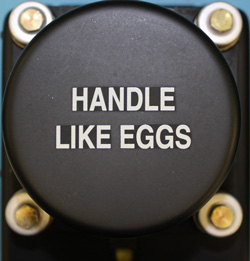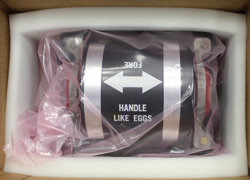Contributed by Scott McKenzie, Avionics Tech Rep and Nic Evans, Gyroscope Team Leader

Remember that a gyro is like an egg, unless you want it scrambled, handle accordingly

Never transport a gyroscope without proper shipping methods.
Gyros are an essential piece of business aircraft avionics equipment and you invest a lot of money to keep them airworthy. They can operate properly for many years or fail in just a few days, whether new in the box or overhauled. It all boils down to the environment in which it is operating and how well you take care of it. When the OEM prints the words “Handle Like Eggs” across every unit, they mean it!
Here are a few things to keep in mind when handling the gyro.
Proper Gyro Handling
- Allow the aircraft to come to a complete stop and sit for at least 15 minutes minimum before attempting to remove the gyro. This gives the gyro time to completely spool down and stop spinning. The newer and more efficient the unit, the longer the gyro will spin.
- Handle Like Eggs, seriously! During transportation is when potentially serious problems can occur. You may send in a unit for a simple fix, but if it is not properly packaged and shipped, then you increase the likelihood of it arriving with a more serious problem. To minimize ground turbulence, a gyro should be shipped by air.
- Do not unplug or plug your gyro in with aircraft power on. Gyros should only be connected or disconnected after they have spooled down completely, minimizing the chance of any excessive vibration from installing or removing the connector to damage the gyro.
- Unpack your overhauled gyro at the aircraft to avoid rumbling it across the ramp on a cart. Dropping a gyro from ½” above a hard surface can do significant damage.
When you need to remove the gyro from the aircraft to troubleshoot squawks or gain further access, the same care should be used.
Proper Gyro Storage
- Anytime a gyro is removed from the aircraft, it should be immediately put into an adequately padded shipping container, if possible.
- Store the gyro flat on a shelf resting on padding in a temperature controlled environment.
- If gyro will be stored for an extended period of time, it should be powered up every six months and allowed to spin for 10-15 minutes. This redistributes the oil or grease throughout the bearings. If left to sit, the oil and grease will pool at the bottom of the unit and cause friction damage of the upper bearings upon the next start-up.
Remember that a gyro is like an egg, unless you want it scrambled, handle accordingly.
Gyro Overhaul
As an Authorized Honeywell Service Center, Duncan Aviation is able to overhaul most Honeywell gyroscopes. If you ship your gyro directly to Duncan aviation for overhaul, you will receive it back within five days using Duncan Aviation's AOG service. Before shipping your gyro to Duncan Aviation for overhaul, please call a Customer Account Rep to get proper packing instructions.
Duncan Aviation has four Avionics Tech Reps at your service to answer your questions or assist in troubleshooting your avionics units, including the gyro.
Scott McKenzie is an avionics tech rep located in Duncan Aviation's Lincoln, Nebraska, facility. He specializes in troubleshooting the latest in avionics systems installed on aircraft today. His aviation career began in 1995.
Nic Evans is an avionics team leader located at Duncan Aviation's Lincoln, Nebraska, facility. He leads a team that specializes in the gyroscope. His aviation career began in 1999.


